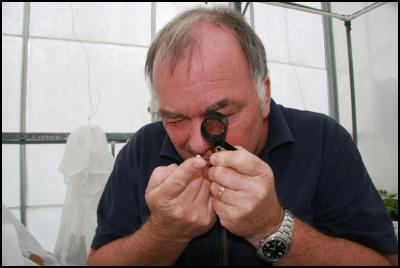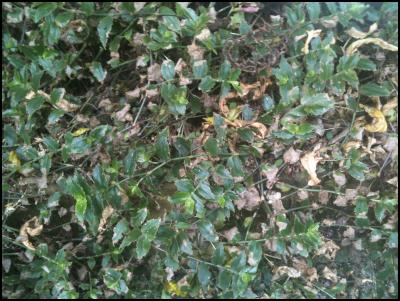Brazilian Beetles Effective Biocontrol Against Tradescantia
Brazilian Beetles Proving Effective Biocontrol Against Tradescantia
Areas where Brazilian beetles were released to control a weed, hated by conservationists, gardeners and dog owners alike, are showing signs it’s working.
The three species of beetle were introduced to New Zealand in 2011 by Landcare Research to combat tradescantia. The weed, commonly known as wandering willie, forms thick blankets that can smother low growing plants and prevents regeneration of native bush. It can also cause dermatitis or allergic reaction in dogs.
The larvae of each of the beetles consume a different part of the plant - the tip, leaf and steam. They are aptly named the tradescantia tip beetle, tradescantia leaf beetle and tradescantia steam beetle.

Landcare Research scientist
Simon Fowler inspecting the pupal case of a tradescantia
leaf beetle.
The beetles have been released at sites around the country. Only one species of beetle have been released at each site to monitor the effect each has individually. There are plans to eventually release all three at one site.
Landcare Research scientist Simon Fowler, who has lead the tradescantia biocontrol research, said he was “overjoyed” to see the damage to the weed during a recent visit to a site in Kerikeri, in Northland, where 300 tradescantia leaf beetles had been released four years ago. About half the leaves on the plants had been stripped bare by the larvae, and the rest were well-chewed by the adult beetles, he said.
“It was jaw dropping to see that. It’s still early days but it’s looking fantastic.”
It comes as a milestone given tradescantia has been very difficult to control using traditional methods including herbicides and manual control. It breaks into many pieces when pulled, with almost every stem capable of resprouting.
Fowler was also impressed by the speed in which the tradescantia leaf beetles were multiplying. He estimated there were now about 5,000 beetles and larvae at the 10 square meter site.
“There were adults and larvae everywhere,” he said.
This dramatic damage was caused by just the tradescantia leaf beetle, but Fowler believed the combination of all three beetles would be the “dream team” to tackle the weed.
“We’re seeing really good damage from all three beetle species individually. Once we finally get all three combined together the results will be amazing. I think it will be a knockout blow.”
Landcare Research technician Lindsay Smith, who assisted with the project, said often multiple biocontrols were required to make an impact.

The damage caused by
tradescantia leaf beetles at a site in Kerikeri.
“One agent will never be the silver bullet. If you can select a range of insects, although they look similar and come from the same place, they eat different parts of the plant. Together they will do significant damage to the weed.”
Researchers are investigating other biocontrols which could assist in tackling tradescantia including a plant disease caused by a pathogenic fungus.
The release of the beetles was approved by the Environmental Protection Authority.
Anyone interested in getting hold of some tradescantia beetles should contact the biosecurity section at their local regional council to register their interest. As beetle populations build adults will be harvested and shared with rate payers free of charge.
ENDS


 Master Plumbers Gasfitters and Drainlayers NZ: 2025 New Zealand Plumbing Conference Awards: Full List Of Winners
Master Plumbers Gasfitters and Drainlayers NZ: 2025 New Zealand Plumbing Conference Awards: Full List Of Winners Insurance Council of New Zealand: Insurers Support Kiwis As Severe Weather Eases
Insurance Council of New Zealand: Insurers Support Kiwis As Severe Weather Eases Science Media Centre: What Goes Into Making Our Seasonal Flu Jab? – Expert Q+A
Science Media Centre: What Goes Into Making Our Seasonal Flu Jab? – Expert Q+A The Document Foundation: Celebrating 20 Years Of The OASIS Open Document Format (ODF) Standard
The Document Foundation: Celebrating 20 Years Of The OASIS Open Document Format (ODF) Standard Maritime Union of New Zealand: Maritime Union Raises Serious Concerns Over Aratere Ferry Removal
Maritime Union of New Zealand: Maritime Union Raises Serious Concerns Over Aratere Ferry Removal Ferry Holdings Limited: Decommissioning Of The Aratere Ferry
Ferry Holdings Limited: Decommissioning Of The Aratere Ferry